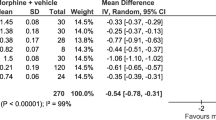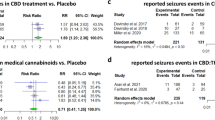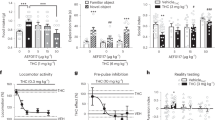Abstract
Cannabinoids, when co-administered with opioids, may enable reduced opioid doses without loss of analgesic efficacy (ie, an opioid-sparing effect). The aim of this study was to conduct a systematic review to determine the opioid-sparing potential of cannabinoids. Eligible studies included pre-clinical and clinical studies for which the outcome was either analgesia or opioid dose requirements. Clinical studies included controlled studies and case series. We searched Scopus, Cochrane Database of Systematic Reviews, Medline, and Embase. Nineteen pre-clinical and nine clinical studies met the search criteria. Seventeen of the 19 pre-clinical studies provided evidence of synergistic effects from opioid and cannabinoid co-administration. Our meta-analysis of pre-clinical studies indicated that the median effective dose (ED50) of morphine administered in combination with delta-9-tetrahydrocannabinol (delta-9-THC) is 3.6 times lower (95% confidence interval (CI) 1.95, 6.76; n=6) than the ED50 of morphine alone. In addition, the ED50 for codeine administered in combination with delta-9-THC was 9.5 times lower (95% CI 1.6, 57.5, n=2) than the ED50 of codeine alone. One case series (n=3) provided very-low-quality evidence of a reduction in opioid requirements with cannabinoid co-administration. Larger controlled clinical studies showed some clinical benefits of cannabinoids; however, opioid dose changes were rarely reported and mixed findings were observed for analgesia. In summary, pre-clinical studies provide robust evidence of the opioid-sparing effect of cannabinoids, whereas one of the nine clinical studies identified provided very-low-quality evidence of such an effect. Prospective high-quality-controlled clinical trials are required to determine the opioid-sparing effect of cannabinoids.
Similar content being viewed by others
Log in or create a free account to read this content
Gain free access to this article, as well as selected content from this journal and more on nature.com
or
References
Abrams DI, Couey P, Shade SB, Kelly ME, Benowitz NL (2011). Cannabinoid-opioid interaction in chronic pain. Clin Pharmacol Ther 90: 844–851.
Berge O-G (2011). Predictive validity of behavioural animal models for chronic pain. Br J Pharmacol 164: 1195–1206.
Boehnke KF, Litinas E, Clauw DJ (2016). Medical cannabis use is associated with decreased opiate medication use in a retrospective cross-sectional survey of patients with chronic pain. J Pain 17: 739–744.
Cencioni MT, Chiurchiu V, Catanzaro G, Borsellino G, Bernardi G, Battistini L et al (2010). Anandamide suppresses proliferation and cytokine release from primary human T-lymphocytes mainly via CB2 receptors. PLoS ONE 5: e8688.
Chou R, Turner JA, Devine EB, Hansen RN, Sullivan SD, Blazina I et al (2015). The effectiveness and risks of long-term opioid therapy for chronic pain: a systematic review for a National Institutes of Health Pathways to Prevention Workshop Effectiveness and Risks of Long-Term Opioid Therapy for Chronic Pain. Ann Intern Med 162: 276–286.
Cichewicz DL (2004). Synergistic interactions between cannabinoid and opioid analgesics. Life Sci 74: 1317–1324.
Cichewicz DL, Martin ZL, Smith FL, Welch SP (1999). Enhancement mu opioid antinociception by oral delta9-tetrahydrocannabinol: dose-response analysis and receptor identification. J Pharmacol Exp Ther 289: 859–867.
Cichewicz DL, McCarthy EA (2003). Antinociceptive synergy between delta(9)-tetrahydrocannabinol and opioids after oral administration. J Pharmacol Exp Ther 304: 1010–1015.
Cichewicz DL, Welch SP (2003). Modulation of oral morphine antinociceptive tolerance and naloxone-precipitated withdrawal signs by oral Delta 9-tetrahydrocannabinol. J Pharmacol Exp Ther 305: 812–817..
Cichewicz DL, Welch SP, Smith FL (2005). Enhancement of transdermal fentanyl and buprenorphine antinociception by transdermal delta9-tetrahydrocannabinol. Eur J Pharmacol 525: 74–82.
Cox ML, Haller VL, Welch SP (2007). Synergy between delta9-tetrahydrocannabinol and morphine in the arthritic rat. Eur J Pharmacol 567: 125–130.
da Fonseca Pacheco D, Klein A, de Castro Perez A, da Fonseca Pacheco CM, de Francischi JN, Duarte ID (2008). The mu-opioid receptor agonist morphine, but not agonists at delta- or kappa-opioid receptors, induces peripheral antinociception mediated by cannabinoid receptors. Br J Pharmacol 154: 1143–1149.
Degenhardt L, Lintzeris N, Campbell G, Bruno R, Cohen M, Farrell M et al (2015). Experience of adjunctive cannabis use for chronic non-cancer pain: findings from the Pain and Opioids IN Treatment (POINT) study. Drug Alcohol Depend 147: 144–150.
Dowell D, Haegerich TM, Chou R (2016). CDC Guideline for Prescribing Opioids for Chronic Pain - United States, 2016. MMWR Recomm Rep 65: 1–49.
Finn DP, Beckett SR, Roe CH, Madjd A, Fone KC, Kendall DA et al (2004). Effects of coadministration of cannabinoids and morphine on nociceptive behaviour, brain monoamines and HPA axis activity in a rat model of persistent pain. Eur J Neurosci 19: 678–686.
Gui H, Tong Q, Qu W, Mao CM, Dai SM (2015). The endocannabinoid system and its therapeutic implications in rheumatoid arthritis. Int Immunopharmacol 26: 86–91.
Guyatt GH, Oxman AD, Vist GE, Kunz R, Falck-Ytter Y, Alonso-Coello P et al (2008). GRADE: an emerging consensus on rating quality of evidence and strength of recommendations. Br Med J 336: 924–926.
Haroutounian S, Ratz Y, Ginosar Y, Furmanov K, Saifi F, Meidan R et al (2016). The effect of medicinal cannabis on pain and quality of life outcomes in chronic pain: a Prospective Open-label Study. Clin J Pain 32: 1036–1043.
Herkenham M, Lynn AB, Johnson MR, Melvin LS, de Costa BR, Rice KC (1991). Characterization and localization of cannabinoid receptors in rat brain: a quantitative in vitro autoradiographic study. J Neurosci 11: 563–583.
Hohmann AG, Briley EM, Herkenham M (1999). Pre- and postsynaptic distribution of cannabinoid and mu opioid receptors in rat spinal cord. Brain Res 822: 17–25.
Holdcroft A, Smith M, Jacklin A, Hodgson H, Smith B, Newton M et al (1997). Pain relief with oral cannabinoids in familial Mediterranean fever. Anaesthesia 52: 483–486.
Houser SJ, Eads M, Embrey JP, Welch SP (2000). Dynorphin B and spinal analgesia: induction of antinociception by the cannabinoids CP55,940, Delta(9)-THC and anandamide. Brain Res 857: 337–342.
Howlett AC, Barth F, Bonner TI, Cabral G, Casellas P, Devane WA et al (2002). International Union of Pharmacology. XXVII. Classification of cannabinoid receptors. Pharmacol Rev 54: 161–202.
Ibrahim M, Rude M, Stagg N, Mata H, Lai J, Vanderah T et al (2006). CB2 cannabinoid receptor mediation of antinociception. Pain 122: 36–42.
Ibrahim MM, Porreca F, Lai J, Albrecht PJ, Rice FL, Khodorova A et al (2005). CB2 cannabinoid receptor activation produces antinociception by stimulating peripheral release of endogenous opioids. Proc Natl Acad Sci USA 102: 3093–3098.
Jensen B, Chen J, Furnish T, Wallace M (2015). Medical marijuana and chronic pain: a review of basic science and clinical evidence. Curr Pain Headache Rep 19: 50.
Johnson JR, Burnell-Nugent M, Lossignol D, Ganae-Motan ED, Potts R, Fallon MT (2010). Multicenter, double-blind, randomized, placebo-controlled, parallel-group study of the efficacy, safety, and tolerability of THC:CBD extract and THC extract in patients with intractable cancer-related pain. J Pain Symptom Manage 39: 167–179.
Katsuyama S, Mizoguchi H, Kuwahata H, Komatsu T, Nagaoka K, Nakamura H et al (2013). Involvement of peripheral cannabinoid and opioid receptors in beta-caryophyllene-induced antinociception. Eur J Pain 17: 664–675.
Li JX, McMahon LR, Gerak LR, Becker GL, France CP (2008). Interactions between Delta(9)-tetrahydrocannabinol and mu opioid receptor agonists in rhesus monkeys: discrimination and antinociception. Psychopharmacology 199: 199–208.
Lissoni P, Porro G, Messina G, Porta E, Rovelli F, Roselli MG et al (2014). Morphine, melatonin, Marijuana, Magnolia and MYRRH as the "five m" schedule in the treatment of cancer pain and the possible dose-dependency of the antitumor and analgesic effects of the pineal hormone melatonin. Anticancer Res 34: 6033–6034.
Litchfield JA, Wilcoxon F (1949). A simplified method of evaluating dose-effect experiments. J Pharmacol Exp Ther 96: 99–113.
Lynch ME, Clark AJ (2003). Cannabis reduces opioid dose in the treatment of chronic non-cancer pain. J Pain Symptom Manage 25: 496–498.
Maguire DR, Yang W, France CP (2013). Interactions between mu-opioid receptor agonists and cannabinoid receptor agonists in rhesus monkeys: antinociception, drug discrimination, and drug self-administration.(Erratum appears in J Pharmacol Exp Ther. 2014 Mar; 348(3): 490-1 Note: Dosage error in article text). J Pharmacol Exp Ther 345: 354–362.
Manzanares J, Corchero J, Romero J, Fernandez-Ruiz JJ, Ramos JA, Fuentes JA (1999). Pharmacological and biochemical interactions between opioids and cannabinoids. Trends Pharmacol Sci 20: 287–294.
Mason DJ Jr, Lowe J, Welch SP (1999). Cannabinoid modulation of dynorphin A: correlation to cannabinoid-induced antinociception. Eur J Pharmacol 378: 237–248.
Moher D, Liberati A, Tetzlaff J, Altman DG (2009). Preferred reporting items for systematic reviews and meta-analyses: the PRISMA statement. PLoS Med 6: e1000097.
Naef M, Curatolo M, Petersen-Felix S, Arendt-Nielsen L, Zbinden A, Brenneisen R (2003). The analgesic effect of oral delta-9-tetrahydrocannabinol (THC), morphine, and a THC-morphine combination in healthy subjects under experimental pain conditions. Pain 105: 79–88.
Narang S, Gibson D, Wasan AD, Ross EL, Michna E, Nedeljkovic SS et al (2008). Efficacy of dronabinol as an adjuvant treatment for chronic pain patients on opioid therapy. J Pain 9: 254–264.
Pertwee RG (2006). The pharmacology of cannabinoid receptors and their ligands: an overview. Int J Obes 30: S13–S18.
Pertwee RG (2008). The diverse CB1 and CB2 receptor pharmacology of three plant cannabinoids: delta9-tetrahydrocannabinol, cannabidiol and delta9-tetrahydrocannabivarin. Br J Pharmacol 153: 199–215.
Portenoy RK, Ganae-Motan ED, Allende S, Yanagihara R, Shaiova L, Weinstein S et al (2012). Nabiximols for opioid-treated cancer patients with poorly-controlled chronic pain: a randomized, placebo-controlled, graded-dose trial. J Pain 13: 438–449.
Pugh G Jr, Mason DJ Jr, Combs V, Welch SP (1997). Involvement of dynorphin B in the antinociceptive effects of the cannabinoid CP55,940 in the spinal cord. J Pharmacol Exp Ther 281: 730–737.
Pugh G Jr, Smith PB, Dombrowski DS, Welch SP (1996). The role of endogenous opioids in enhancing the antinociception produced by the combination of DELTA9-tetrahydrocannabinol and morphine in the spinal cord. J Pharmacol Exp Ther 279: 608–616.
Quartilho A, Mata HP, Ibrahim MM, Vanderah TW, Porreca F, Makriyannis A et al (2003). Inhibition of inflammatory hyperalgesia by activation of peripheral CB2 cannabinoid receptors. Anesthesiology 99: 955–960.
Reche I, Fuentes JA, Ruiz-Gayo M (1996). Potentiation of delta 9-tetrahydrocannabinol-induced analgesia by morphine in mice: involvement of mu- and kappa-opioid receptors. Eur J Pharmacol 318: 11–16.
Rice AS, Smith BH, Blyth FM (2015). Pain and the global burden of disease. Pain 157: 791–796.
Roberts JD, Gennings C, Shih M (2006). Synergistic affective analgesic interaction between delta-9- tetrahydrocannabinol and morphine. Eur J Pharmacol 530: 54–58.
Salio C, Fischer J, Franzoni MF, Mackie K, Kaneko T, Conrath M (2001). CB1-cannabinoid and mu-opioid receptor co-localization on postsynaptic target in the rat dorsal horn. NeuroReport 12: 3689–3692.
Seeling W, Kneer L, Buchele B, Gschwend J, Maier L, Nett C et al (2006). DELTA9-tetrahydrocannabinol and the opioid receptor agonist piritramide do not act synergistically in postoperativepain. Anaesthesist 55: 391–400.
Smith FL, Cichewicz D, Martin ZL, Welch SP (1998). The enhancement of morphine antinociception in mice by delta9-tetrahydrocannabinol. Pharmacol Biochem Behav 60: 559–566.
Smith PA, Selley DE, Sim-Selley LJ, Welch SP (2007). Low dose combination of morphine and delta9-tetrahydrocannabinol circumvents antinociceptive tolerance and apparent desensitization of receptors. Eur J Pharmacol 571: 129–137.
Smith PB, Welch SP, Martin BR (1994). Interactions between delta 9-tetrahydrocannabinol and kappa opioids in mice. J Pharmacol Exp Ther 268: 1381–1387.
Tham SM, Angus JA, Tudor EM, Wright CE (2005). Synergistic and additive interactions of the cannabinoid agonist CP55,940 with mu opioid receptor and alpha2-adrenoceptor agonists in acute pain models in mice. Br J Pharmacol 144: 875–884.
Valverde O, Noble F, Beslot F, Dauge V, Fournie-Zaluski MC, Roques BP (2001). Delta9-tetrahydrocannabinol releases and facilitates the effects of endogenous enkephalins: reduction in morphine withdrawal syndrome without change in rewardingeffect. Eur J Neurosci 13: 1816–1824.
Vigano D, Rubino T, Parolaro D (2005). Molecular and cellular basis of cannabinoid and opioid interactions. Pharmacol Biochem Behav 81: 360–368.
Volkow ND, McLellan AT (2016). Opioid abuse in chronic pain — misconceptions and mitigation strategies. N Engl J Med 374: 1253–1263.
Wakley AA, Craft RM (2011). THC-methadone and THC-naltrexone interactions on discrimination, antinociception, and locomotion in rats. Behav Pharmacol 22: 489–497.
Walker JM, Hohmann AG, Martin WJ, Strangman NM, Huang SM, Tsou K (1999). The neurobiology of cannabinoid analgesia. Life Sci 65: 665–673.
Walker JM, Huang SM (2002). Cannabinoid analgesia. Pharmacol Ther 95: 127–135.
Ware MA, Fitzcharles M-A, Joseph L, Shir Y (2010a). The effects of nabilone on sleep in fibromyalgia: results of a randomized controlled trial. Anesth Analg 110: 604–610.
Ware MA, Wang T, Shapiro S, Robinson A, Ducruet T, Huynh T et al (2010b). Smoked cannabis for chronic neuropathic pain: a randomized controlled trial. CMAJ 182: E694–E701.
Welch SP, Stevens DL (1992). Antinociceptive activity of intrathecally administered cannabinoids alone, and in combination with morphine, in mice. J Pharmacol Exp Ther 262: 10–18.
Williams IJ, Edwards S, Rubo A, Haller VL, Stevens DL, Welch SP (2006). Time course of the enhancement and restoration of the analgesic efficacy of codeine and morphine by δ9-tetrahydrocannabinol. Eur J Pharmacol 539: 57–63.
Williams J, Haller VL, Stevens DL, Welch SP (2008). Decreased basal endogenous opioid levels in diabetic rodents: effects on morphine and delta-9-tetrahydrocannabinoid-induced antinociception. Eur J Pharmacol 584: 78–86.
Wilson AR, Maher L, Morgan MM (2008). Repeated cannabinoid injections into the rat periaqueductal gray enhance subsequent morphine antinociception. Neuropharmacology 55: 1219–1225.
Woodhams SG, Sagar DR, Burston JJ, Chapman V (2015). The role of the endocannabinoid system in pain. Handb Exp Pharmacol 227: 119–143.
Yesilyurt O, Dogrul A, Gul H, Seyrek M, Kusmez O, Ozkan Y et al (2003). Topical cannabinoid enhances topical morphine antinociception. Pain 105: 303–308.
Zedler B, Xie L, Wang L, Joyce A, Vick C, Kariburyo F et al (2014). Risk factors for serious prescription opioid-related toxicity or overdose among veterans health administration patients. Pain Med 15: 1911–1929.
Acknowledgements
SN, PS, JMT, MAW, BM, NL, KEK, MF, AS, and BLF were involved in the conceptualization of the work. SN and PS screened the abstracts. SN, PS, and JMT extracted the data and checked the extracted data. BBS transformed the data, prepared the data for meta-analysis, and provided advice on the meta-analysis. SN conducted the meta-analysis and drafted the manuscript with assistance from BM, PS, and JMT. All authors revised the manuscript and approved the final version.
Author information
Authors and Affiliations
Corresponding author
Additional information
Supplementary Information accompanies the paper on the Neuropsychopharmacology website
Supplementary information
Rights and permissions
About this article
Cite this article
Nielsen, S., Sabioni, P., Trigo, J. et al. Opioid-Sparing Effect of Cannabinoids: A Systematic Review and Meta-Analysis. Neuropsychopharmacol 42, 1752–1765 (2017). https://doi.org/10.1038/npp.2017.51
Received:
Revised:
Accepted:
Published:
Issue date:
DOI: https://doi.org/10.1038/npp.2017.51
This article is cited by
-
Clinical and psychosocial changes in adults with opioid use disorder and chronic pain using medical cannabis: a brief report
Journal of Cannabis Research (2025)
-
Cannabinoid CB1 receptor and mu-opioid receptor interaction: new insights from conditional knockout mice
Neuropsychopharmacology (2025)
-
Medicine vs. Myth: Exploring the Therapeutic Potential of Cannabis for Opioid Use Disorder and Pain
Current Addiction Reports (2025)
-
Supporting gut health with medicinal cannabis in people with advanced cancer: potential benefits and challenges
British Journal of Cancer (2024)
-
Clinical Benefits and Safety of Medical Cannabis Products: A Narrative Review on Natural Extracts
Pain and Therapy (2024)



